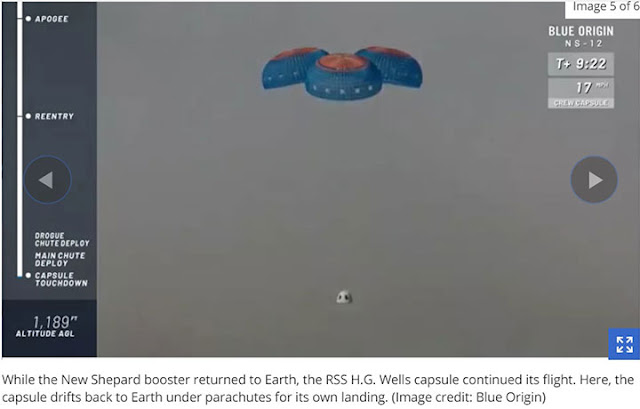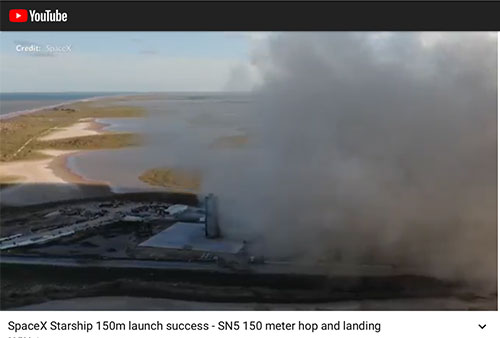Well, this week we have mostly been preoccupied with space events. First up is the successful performance of the SpaceX Crew Dragon capsule that took astronauts to the ISS after launching from KSC and then returning them to Earth a couple of months latter. Good job everyone!
 |
| NASA astronauts emerge from the SpaceX Crew Dragon (Source: Wall Street Journal) |
Other space news includes the successful testing of other commercial rockets and spacecraft like the Blue Origins New Shepard rocket booster. The testing of this vehicle for getting into space is being conducted at the Blue Origins test facility near Van Horn, TX. This test site is in the mostly vacant part of West Texas and probably can't launch into orbit from there, but test and development can go on. Congratulations Amazon and Blue Origin team!
 |
| Blue Shepard test vehicle launches from facility near Van Horn, Texas (Source: space.com) |
Just in case, you wondered where in Texas these tests are being conducted, check out the map below. So, you can see that it is probably easiest for us to visit that site by flying into El Paso and then driving. The good news about that location is that there the SDSS telescopes are located outside of Las Cruces and you can make a drive up to Roswell, NM, if you choose to do so. It is however, quite a long distance down to Brownsville and SpaceX Boca Chick launch site.
 | |
|
This flight test demonstrates that the Blue Shepard can launch a test space capsule and then return and land for reuse. The capsule just parachutes back to Earth.
 | |
|
Here we can see the New Shepard booster back on the ground.
 |
| Here we can see the New Shepard booster back on the ground (Source: space.com) |
The other big space news for the week was the successful 150 meter test hop of Starship SN5. I had been watching, several days now in anticipation of seeing the test hop live, but each time, the test hop was cancelled and postponed due to various technical problems. But, first of all, we should remember that this SN5 test prototype is 9 meters in diameter and 30 meters tall. You can get a sense of its size in this photo showing work personnel making some final adjustments.
 |
| The Starship SN5 prototype mounted on its launch pad (Source: @BocaChicaGal) |
So, finally in this photo tweeted by Elon Musk, we see the Starship prototype just leaving the ground.
 |
| Starship SN5 lifts off from Boca Chica (Source: Elon Musk) |
In this next photo, you can see the area surrounding the launch site. Texas State Highway #4 crosses at the bottom left of the photo, with the Star Hopper prototype to the right, and ends at Boca Chica beach just out of view.
 | |
|
In this next photo you can see the Starship in flight. Yep, it sure does look like a flying water heater or a corn silo. The "knob" on top of the tank is a huge roll of steel that acts like a dead weight for the nose cone and other equipment which will be added at the next stage of testing.
 | |
|
While the amateur SpaceX fans can peer through the fence, we get some great views of launch from inside of the rocket itself from SpaceX. Check out this inside view, looking down toward the ground. You can see one Raptor engine, where three Raptors will be mounted when the fully developed Starship becomes operational. In later images of the image, you can see what looks like some other fires aboard the rocket, but we don't have any info about that.
 | |
|
But, the test hop is not over until the Starship comes back down and lands under its own power. The rocket is guided back down and the landing lets pop out and the end of the flight comes with a successful landing. Go Elon!
 | |
|
If you want to view the videos of the site there are many sources available from SpaceX fans who volunteer to hang out in Boca Chica and peer through the fence and report back to the rest of us about progress there. SPadre, @SpacePadreisle provides more images and narration. We have thanked many times, Mary, @BocaChicaGal, for her images and this time, we have a thank you and shout out for narration and comments about the launch and Starship program from Marcus House. He reports and comments on some great video shots at his YouTube channel: https://www.youtube.com/watch?v=ZCGWX_ejolw
Finally, after all of this good space news, I found time to get the Raspberry Shake Seismograph out of the packing and started its setup. You might recall that I heard of this low cost seismograph, built around an internet connectable Raspberry Pi computer, after hearing about from OCA Astroimager, David, and others, that they had successfully installed the system. So, since I had previously spent many years working for Big Oil and spent many hours building instrumentation for the exploration departments, I wanted to get my own seismograph.
 |
| Get your own seismograph and monitor for earthquakes (Source: www.raspberryshake.org) |
By the time, the desire shook the money out of my credit card, the pandemic was in full force around the world. Raspberry Shake has their operation in Panama and they we shut down there too. But eventually, the unit was shipped and arrived here. So, the installation looked easy enough, it took me over a month to finally bite the bullet and unwrap the equipment and set it up.
 |
| The Raspberry Shake as seen out of the shipping package (Source: Palmia Observatory) |
Finally, I connected the unit to our internet router and plugged in the power supply and just a couple of minutes latter, I could view the helicorder output. Wow, pretty neat! The seismograph can be part of a whole net of instruments located around the world as part of an internet observable network. I haven't figured out anything about the scaling of vertical accelerations yet. I did try stamping my feet near the unit and these can be identified on the red trace. Yeah, stamping my feet is how I would found out if some seismic recording equipment I was building, now over 25 years ago, for Big Oil was working or not. So, still some more details to be worked out here as we stay in our burrows!
 |
| Hey, the Raspberry Shake actually works (Source: Palmia Observatory) |
Until next time, here from our burrow, stay safe, as we recover more of our freedom,
Resident Astronomer George
Be sure to check out over 400 other blog posts on similar topics
If you are interested in things astronomical or in astrophysics and cosmology
Check out this blog at www.palmiaobservatory.com

No comments:
Post a Comment